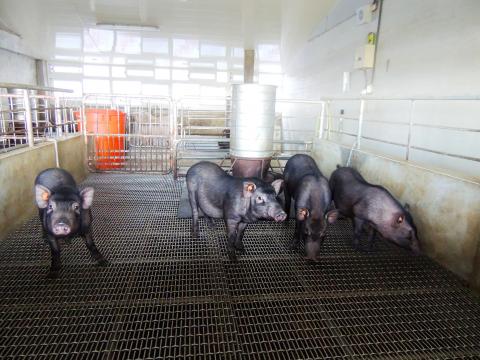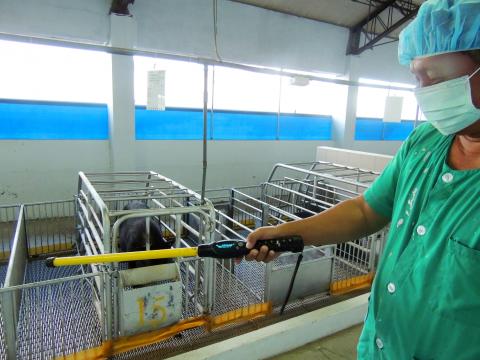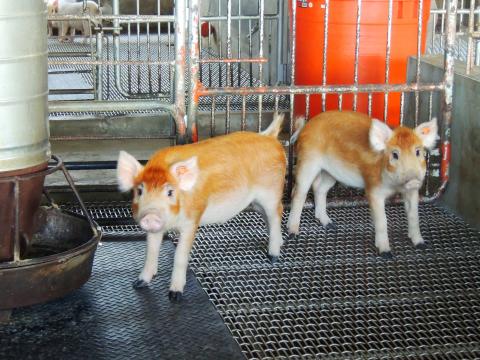The Taitung Animal Propagation Station handles its pigs with the kind of care reserved for patients in quarantine.
Before entering the mountainside facility, workers at the station put on gloves, masks and scrubs, and rinse their plastic white boots in a plate of disinfectant.
Inside, everybody moves slowly. The pigs — some 700 Lanyu miniature pigs — come up to sniff, but will bolt at any sudden movement. To soothe them, station manager Chu Hsien-pin (朱賢斌) puts on Bach’s Cello Suite No. 1 by Yo-yo Ma (馬友友).

Photo: Enru Lin, Taipei Times
“A few years ago it occurred to me that music could help them to relax. At an international conference, I asked one of the panelists, ‘Can pigs appreciate music?’ He responded that nobody has done this study, and that he couldn’t say,” Chu said.
“So then I asked a woman in Taipei who owned a pet pig. She said, ‘Of course they can.’ She said her pig rams up against the door when it hears vocal music, ICRT or heavy metal, but that it likes classical music with 60 beats per minute.”
From plate to lab

Photo: Enru Lin, Taipei Times
Just five years ago, the facility looked very different. Its open-air barns housed muddy pigs in sties, which on summer days drew a cloud of insects.
Meanwhile, Chu and the government station’s other employees were the butt of jokes. Tasked with developing new varieties of commercial hogs, they were unable, year after year, to best, or even match, the local swine farmers’ own research and development, which regularly resulted in cheaper, leaner and more flavorful lines.
“Sometimes we even had to beg local farmers to buy our pigs. They told us, ‘This is what happens when you get public servants to tend a few pigs,’” he said.

Photo: Enru Lin, Taipei Times
In 2008, the Council of Agriculture (COA) offered the station a grant to develop standardized pigs for the medical industry. Chu leapt at the chance. “I told my coworkers, we don’t have any other option. There’s no future for us in the culinary pigs,” he said.
Now the station breeds miniature pigs for biomedical research. It’s a much more successful venture: The farm has developed four lines, and sold over 500 pigs last year. Since 2008, sales have increased year-on-year every year.
Anesthesia included
The new venture is growing steadily because there is no comparable industry in the private sector.
Chu, who said he never liked the commercial hog business, found that raising lab pigs felt better on his conscience.
“With commercial swine, you have to do what is cost efficient. With lab pigs, it’s fine to care for their well-being,” he said.
In February, the station earned accreditation from the Association for Assessment and Accreditation of Laboratory Animal Care (AAALAC), becoming Taiwan’s first large-scale, globally recognized lab pig producer. The award means the station meets certain standards for humane care.
Unlike nearly all farms in Taiwan, the station has spotless pens, toys and room enough for pigs to walk, and even run. Here, male pigs are neutered under anesthesia.
“Most farms neuter the pigs while they are fully conscious. We used to do that, too. The workers would be sweating, the pig would be crying and everybody was terrified.”
Using the COA grant, Chu installed a filter system for the pigs’ water, and purchased a truck that transports them to their labs. The truck has air conditioning for the summer, and a heater for the winter. A drinking fountain supplies fresh water.
Worthy cause?
Still, at their final destination, the pigs invariably die. They are killed, either on the operating table or when euthanized shortly afterward.
In 2010, National Taiwan University researchers reported that it successfully stimulated complete tooth regeneration in a Lanyu miniature pig, by combining its bone marrow with molar tooth buds. That live experiment resulted in a breakthrough, but many, even promising ones, don’t. Before a project runs its course, it is hard to tell whether the death of the pig is worthwhile.
At the station, workers who work directly with the pigs say they keep their distance.
“How labs use them is out of our hands,” said Huang Min-hsiung (黃敏雄), a Taitung native who oversees the pen’s day-to-day operations.
Fastidious about cleanliness, workers touch their charges only when necessary, and only when wearing latex gloves. Huang stressed that the animals are identified by number: There is no naming of the pigs, which due to selective breeding, come in the color of a Dalmatian and a fawn.
Last preserve
Though coat colors differ, the pigs are all from the same breed. Twenty-five kilograms at maturity, the Lanyu miniature pig has small ears, a wasp-like waist and cloven hooves that are surprisingly dainty.
On their native Orchid Island, the Tao Aboriginal people keep them as housepets, and eat them on special occasions. On balmy afternoons, pigs sleep at the foot of owners or root in human hands for carrots.
At the Taitung station, the Lanyu miniature pigs display a different temperament. Even as piglets, they are sensitive and skittish at a pin-drop.
They are also inbred, but new specimens for breeding are hard to find. Back on Orchid Island, the indigenous breed is disappearing, due to uncontrolled interbreeding with imported foreign pigs, which the locals now prefer for their flavor.
Chu is communicating with the islet’s non-governmental organizations about preservation projects that use his own station’s genetic material. “In 50 years, it is possible that the only purebred Lanyu pigs will be the ones here at this facility,” he said.

May 11 to May 18 The original Taichung Railway Station was long thought to have been completely razed. Opening on May 15, 1905, the one-story wooden structure soon outgrew its purpose and was replaced in 1917 by a grandiose, Western-style station. During construction on the third-generation station in 2017, workers discovered the service pit for the original station’s locomotive depot. A year later, a small wooden building on site was determined by historians to be the first stationmaster’s office, built around 1908. With these findings, the Taichung Railway Station Cultural Park now boasts that it has

The latest Formosa poll released at the end of last month shows confidence in President William Lai (賴清德) plunged 8.1 percent, while satisfaction with the Lai administration fared worse with a drop of 8.5 percent. Those lacking confidence in Lai jumped by 6 percent and dissatisfaction in his administration spiked up 6.7 percent. Confidence in Lai is still strong at 48.6 percent, compared to 43 percent lacking confidence — but this is his worst result overall since he took office. For the first time, dissatisfaction with his administration surpassed satisfaction, 47.3 to 47.1 percent. Though statistically a tie, for most

Six weeks before I embarked on a research mission in Kyoto, I was sitting alone at a bar counter in Melbourne. Next to me, a woman was bragging loudly to a friend: She, too, was heading to Kyoto, I quickly discerned. Except her trip was in four months. And she’d just pulled an all-nighter booking restaurant reservations. As I snooped on the conversation, I broke out in a sweat, panicking because I’d yet to secure a single table. Then I remembered: Eating well in Japan is absolutely not something to lose sleep over. It’s true that the best-known institutions book up faster

In February of this year the Taipei Times reported on the visit of Lienchiang County Commissioner Wang Chung-ming (王忠銘) of the Chinese Nationalist Party (KMT) and a delegation to a lantern festival in Fuzhou’s Mawei District in Fujian Province. “Today, Mawei and Matsu jointly marked the lantern festival,” Wang was quoted as saying, adding that both sides “being of one people,” is a cause for joy. Wang was passing around a common claim of officials of the People’s Republic of China (PRC) and the PRC’s allies and supporters in Taiwan — KMT and the Taiwan People’s Party — and elsewhere: Taiwan and